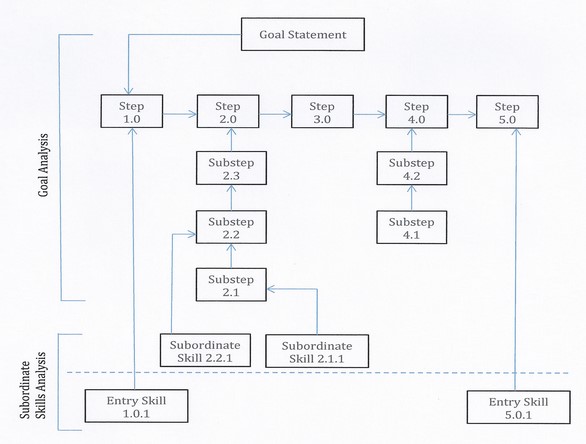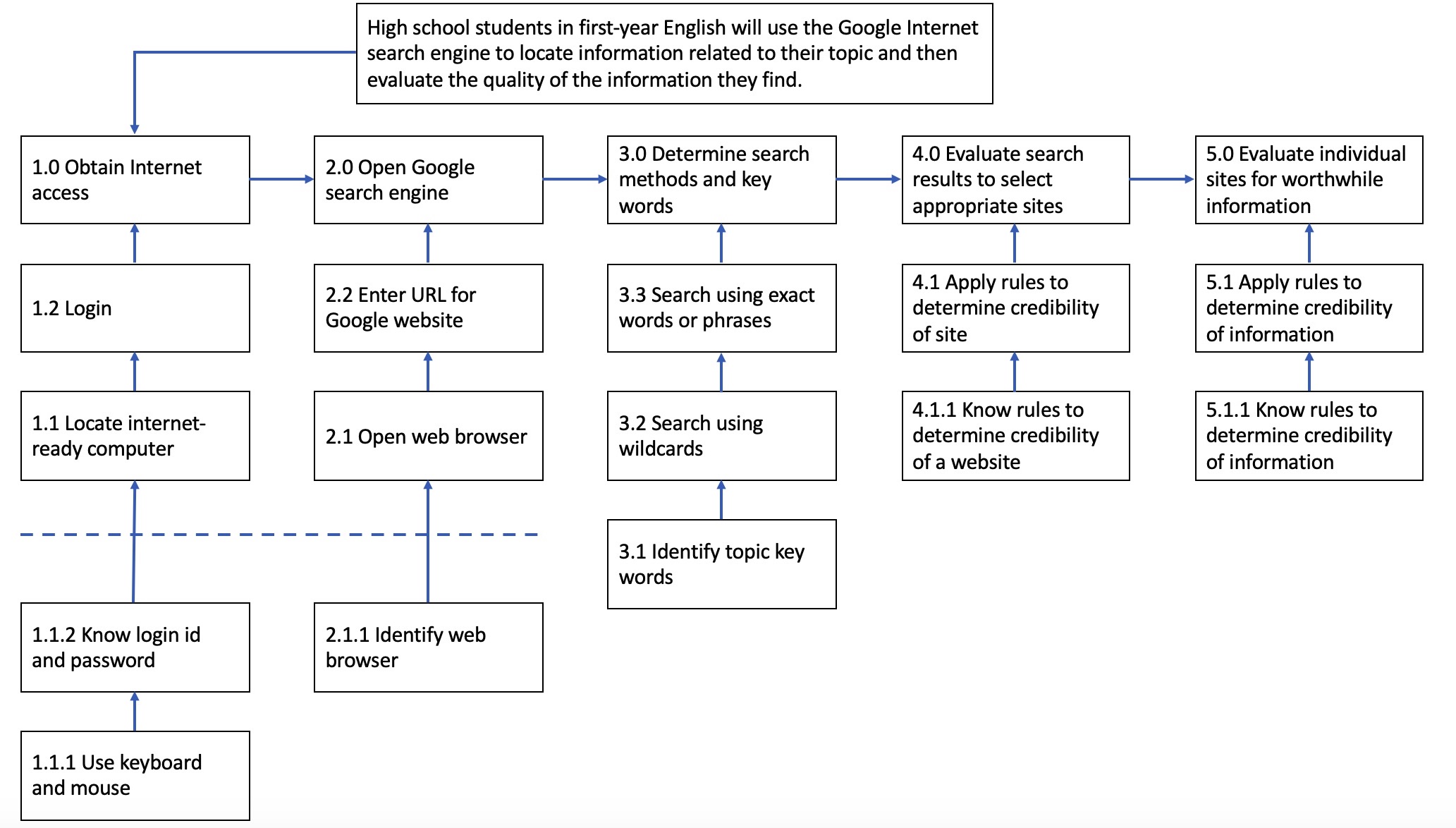Lesson 6: Subordinate Skills Analysis
Reading
Read Chapter 4, Identifying Subordinate and Entry Skills, from Dick, Carey, and Carey
Introduction
In the last lesson, we discussed the first step in the instructional analysis process involving classifying the goal statement then identifying the steps and substeps required to perform the goal. In this lesson, we will look at the next step in the instructional analysis process - the Subordinate Skills Analysis. This analysis identifies the knowledge and skills needed to perform the steps and substeps associated with the goal. Doing this allows you to decide which skills and knowledge must be addressed in the instruction and which ones the learners will possess before they are exposed to the instruction.
The Subordinate Skills Analysis
The subordinate skills analysis involves analyzing each of the major steps and substeps to
determine what skills or knowledge are required to be able to perform that step. These skills and
knowledge are called subordinate skills. In the last lesson you identified the steps and substeps of
the process that an expert or skilled person would use to reach the goal. The subordinate skills
add the knowledge and the prior skills that are necessary to complete the actions in the process.
For example, in order to create a basic document in Microsoft Word you would need to open the
program, type some text, and then save the document. To complete these steps, you would need
the skills to operate a keyboard and possibly a mouse. You would also need the knowledge to
be able to operate a keyboard and a mouse as well as locate and open the MS Word program.
These skills and knowledge are subordinate to the steps and substeps required to produce the
basic MS Word document, and therefore, identified as subordinate skills.
Why is it important to identify these subordinate skills if they are not part of the main steps
towards achieving the goal? Before performing an activity identified in a step or substep, the
learners must (1) know how to perform the activity, and (2) possess the skills and knowledge
needed to perform the activity. The learners may possess some of the necessary knowledge
and/or skills, but will need instruction to acquire the remaining knowledge and skills. Without a
complete inventory of relevant knowledge and skills, important instructional components could
be omitted.
Entry Knowledge and Skills
The final step in the instructional analysis process is to determine which of the subordinate skills are entry skills. Subordinate skills can be classified as entry skills if they would not need to be included in any instruction for the intended learners. For example, let's use the example of creating a basic MS Word document introduced earlier. The subordinate skills identified include the knowledge and skills to operate a keyboard and possibly a mouse, as well as the knowledge to locate the program and open it. You know your learners will be able to use a keyboard and a mouse and know where to find the program and how to open it. Because they will have this knowledge and these skills, they are reclassified as entry skills. Entry skills are gained from an earlier source and are not included in your instruction.The Hierarchical Flowchart
Now that the subordinate skills and entry skills have been identified, it's time to create a new
flowchart that diagrams the goal, steps, substeps, subordinate skills, and entry skills. This will be
done using a hierarchical approach.
The hierarchical approach creates a step-by-step hierarchy of skills and knowledge needed to
complete the goal. It places the most basic information at the bottom and builds upon each
successive addition. In instructional design, the entry skills are the basic information that all
learners will need to have in order to proceed. A dashed line separates the entry skills from the
subordinate skills. Above the entry skills are the subordinate skills identified as the knowledge
and skills needed to complete the actions. Next are the substeps, then the steps.
The diagram below illustrates a basic hierarchical flowchart:

Here is one way to diagram the Google search engine goal using a hierarchical approach:

Notice that the entry skills are at the bottom and separated from the rest of the diagram with a
dashed line, and that the substeps are numbered from the bottom up. This creates the hierarchy.
Activity: The Subordinate Skills Analysis
In this activity you will conduct the subordinate skills analysis and create a new flowchart that
includes the goal, steps, and substeps from the previous flowchart as well as the subordinate and
entry skills identified in this analysis.
Step 1: Identify Subordinate Skills
In order for learners to accomplish a specific step associated with your goal, it may be necessary for them to learn something or develop an ability to do something before receiving instruction on that step.In your assignment, respond to the following items:
- For each step and substep in your goal analysis, what must the learners know in order to perform the action? What skill(s) must the learner possess in order to perform the action? Add these subordinate skills where it is needed in the list of steps and sub-steps in the last lesson.
- How did you determine these subordinate skills? (Experience, observation, subject matter experts, etc.?)
Step 2: Identify the Entry Skills
Once you have all of your subordinate skills identified, it's time to determine which of those skills to treat as entry skills.In your assignment, respond to the following items:
- Knowing your learners, which of the subordinate skills and knowledge identified above will they have prior to receiving instruction on the topic?
- How did you decide which skills and knowledge would be entry skills?
Step 3: Diagram the Hierarchical Flowchart
Create a hierarchical flowchart using a software package of your choosing. A few of the more popular ones include:- Inspiration - Good program that is used by many teachers - (30 day free trial).
- Edge Diagrammer - Another good one - (free trial to download).
- SmartDraw - Yet another good one - (free download).
- Visio - Excellent program - (60 day trial version can be downloaded).
Diagramming conventions include the following:
- Goal statement, steps, sub-steps, subordinate skills and knowledge, and entry skills and knowledge are included.
- All steps, sub-steps, and subordinate skills are numbered according to the following rules:
- The major steps are numbered using whole numbers with one decimal place. For example, 1.0, 2.0, 3.0, 4.0, etc.
- The sub-steps for each step are numbered using two-digits, with the number after the decimal changing for each sub-step. For example, 3.1, 3.2, 3.3, etc.
- The subordinate skills are numbered using three digits, with the first two representing the step or sub-step where it is used and the last representing its order in a series of subordinate skills for the step or sub-step. For example, two subordinate skills needed to complete step 2 would be numbered 2.0.1 and 2.0.2, Two subordinate skills needed to complete sub-step 4.3 would be numbered 4.3.1 and 4.3.2.
- Each item (goal, step, sub-step, subordinate skill, and entry skill) is in a separate textbox.
- Major steps are listed horizontally across the page.
- Sub-steps are listed vertically under the step where they are used, with the fist sub-step at the bottom of the list.
- Subordinate skills are listed under the sub-steps, with the first subordinate skill at the bottom of the list.
- Entry skills listed below subordinate skills and are separated from the rest of the flowchart using a dashed or dotted line.
- Arrows connect everything.
- An arrow points from the goal to the first step.
- Arrows point from a step to the next step, indicating the progress toward the goal.
- An arrow points from the subordinate skill to the place in the flowchart where it is needed. This could be a step, sub-step, or subordinate skill. This applies to the entry skills as well.
 It is possible that part of the process taken by the expert involves decisions. Such decision points
are diagrammed using a diamond. Because there are two possible responses to the question
posed in the decision diamond, one arrow will lead to the actions taken after a "Yes" response
and a second arrow will lead to the actions taken after a "No" response. The image below
provides an example of how to diagram decision points.
It is possible that part of the process taken by the expert involves decisions. Such decision points
are diagrammed using a diamond. Because there are two possible responses to the question
posed in the decision diamond, one arrow will lead to the actions taken after a "Yes" response
and a second arrow will lead to the actions taken after a "No" response. The image below
provides an example of how to diagram decision points.

Submitting your Assignment
Your assignment should be produced using Microsoft Word. The title of this assignment is "Subordinate Skills Analysis". Beneath that, enter your name, email address, and the date. Save your assignment using the filename "subordinate_skills". After you have saved your file, go to the student interface and submit your assignment for grading. Click here if you need additional information regarding submission of your assignment.
Assignment: Subordinate Skills Analysis
Points: 20
Grading Criteria:
Identify Subordinate Skills
- Lists the subordinate skills identified for each goal step and substep. (5)- Describes how the subordinate skills were identified. (2)
Identify Entry Skills
- Describes whether or not each subordinate skill will be included in the instruction, or if it will become an entry skills. (3)- Describes how the entry skills were determined. (2)